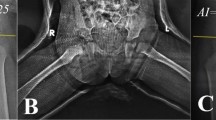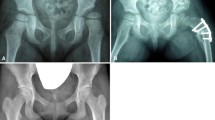Abstract
Background
Osteonecrosis (ON) of the femoral head is one of the main complications associated with treatment of developmental dysplasia of the hips (DDH). The reported rates of ON vary widely between 6% and 48%, suggesting varying factors in these studies influence the rate. Several studies suggest open reduction combined with femoral shortening provides protection against ON. However, it is unclear whether confounders such as failed Pavlik harness treatment, preliminary traction, closed versus open reduction, and redislocation influence the rate of ON.
Questions/purpose
We therefore asked whether open reduction with concomitant osteotomies without femoral shortening, redislocation, and secondary surgical procedures for residual acetabular dysplasia influenced the rate of ON.
Methods
We retrospectively reviewed 64 children (78 hips) hospitalized with developmental dislocation of the hip between January 1998 and February 2007. Patients younger than 12 months were treated with closed or open reduction. Open reduction combined with concomitant pelvic and femoral osteotomies was performed in patients past walking age. ON was diagnosed from radiographs obtained at last followup. We used logistic regression analysis to identify predictors for the development of ON. The minimum followup was 3.2 years (mean, 6.8 years; range, 3.2−11.5 years).
Results
The overall rate of ON was 40%. Patients who underwent open reduction combined with concomitant osteotomies, experienced redislocation, or required secondary reconstructive procedures after initial reduction were at higher risk for having ON develop.
Conclusions
We advocate early reduction of the dislocated hip in the first year of life to avoid the need for concomitant osteotomies combined with open reduction.
Level of Evidence
Level III, therapeutic study. See Guidelines for Authors for a complete description of levels of evidence.





Similar content being viewed by others
References
Aguş H, Omeroğlu H, Uçar H, Biçimoglu A, Türmer Y. Evaluation of the risk factors of avascular necrosis of the femoral head in developmental dysplasia of the hip in infants younger than 18 months of age. J Pediatr Orthop B. 2002;11:41–46
Barrett WP, Staheli LT, Chew DE. The effectiveness of the Salter innominate osteotomy in the treatment of congenital dislocation of the hip. J Bone Joint Surg Am. 1986;68:79–87
Berkeley ME, Dickson JH, Cain TE, Donovan MM. Surgical therapy for congenital dislocation of the hip in patients who are twelve to thirty-six months old. J Bone Joint Surg Am. 1984;66:412–420
Brougham DI, Broughton NS, Cole WG, Menelaus MB. Avascular necrosis following closed reduction of congenital dislocation of the hip: review of influencing factors and long-term follow-up. J Bone Joint Surg Br. 1990;72:557–562
Bucholz RW, Ogden J. Patterns of ischemic necrosis of the proximal femur in nonoperatively treated congenital hip disease. The Hip. Proceedings of the Sixth Open Scientific Meeting of the Hip Society. St Louis, MO: CV Mosby; 1978:20
Carney BT, Clark D, Minter CL. Is the absence of the ossific nucleus prognostic for avascular necrosis after closed reduction of developmental dysplasia of the hip? J Surg Orthop Adv. 2004;13:24–29
Clarke NM, Jowett AJ, Parker L. The surgical treatment of established congenital dislocation of the hip: results of surgery after planned delayed intervention following the appearance of the capital femoral ossific nucleus. J Pediatr Orthop. 2005;25:434–439
Cooperman DR, Wallensten R, Stulberg SD. Post-reduction avascular necrosis in congenital dislocation of the hip. J Bone Joint Surg Am. 1980;62:247–258
Cooperman DR, Wallensten R, Stulberg SD. Acetabular dysplasia in the adult. Clin Orthop Relat Res. 1983;175:79–85
Gage JR, Winter RB. Avascular necrosis of the capital femoral epiphysis as a complication of closed reduction of congenital dislocation of the hip: a critical review of twenty years’ experience at Gillette Children’s Hospital. J Bone Joint Surg Am. 1972;54:373–388
Galpin RD, Roach JW, Wenger DR, Herring JA, Birch JG. One-stage treatment of congenital dislocation of the hip in older children, including femoral shortening. J Bone Joint Surg Am. 1989;71:734–741
Graf R. Fundamentals of sonographic diagnosis of infant hip dysplasia. J Pediatr Orthop. 1984;4:735–740
Gulman B, Tuncay IC, Dabak N, Karaismailoglu N. Salter’s innominate osteotomy in the treatment of congenital hip dislocation: a long-term review. J Pediatr Orthop. 1994;14:662–666
Harris NH, Lloyd-Roberts GC, Gallien R. Acetabular development in congenital dislocation of the hip: with special reference to the indications for acetabuloplasty and pelvic or femoral realignment osteotomy. J Bone Joint Surg Br. 1975;57:46–52
Kahle WK, Anderson MB, Alpert J, Stevens PM, Coleman SS. The value of preliminary traction in the treatment of congenital dislocation of the hip. J Bone Joint Surg Am. 1990;72:1043–1047
Keret D, MacEwen GD. Growth disturbance of the proximal part of the femur after treatment for congenital dislocation of the hip. J Bone Joint Surg Am. 1991;73:410–423
Kershaw CJ, Ware HE, Pattinson R, Fixsen JA. Revision of failed open reduction of congenital dislocation of the hip. J Bone Joint Surg Br. 1993;75:744–749
Klisic P, Jankovic L. Combined procedure of open reduction and shortening of the femur in treatment of congenital dislocation of the hips in older children. Clin Orthop Relat Res. 1976;119:60–69
Lindstrom JR, Ponseti IV, Wenger DR. Acetabular development after reduction in congenital dislocation of the hip. J Bone Joint Surg Am. 1979;61:112–118
Luhmann SJ, Schoenecker PL, Anderson AM, Bassett GS. The prognostic importance of the ossific nucleus in the treatment of congenital dysplasia of the hip. J Bone Joint Surg Am. 1998;80:1719–1727
Malvitz TA, Weinstein SL. Closed reduction for congenital dysplasia of the hip: functional and radiographic results after an average of thirty years. J Bone Joint Surg Am. 1994;76:1777–1792
Mardam-Bey TH, MacEwen GD. Congenital hip dislocation after walking age. J Pediatr Orthop. 1982;2:478–486
McCluskey WP, Bassett GS, Mora-Garcia G, MacEwen GD. Treatment of failed open reduction for congenital dislocation of the hip. J Pediatr Orthop. 1989;9:633–639
Pemberton PA. Pericapsular osteotomy of the ilium for treatment of congenital subluxation and dislocation of the hip. J Bone Joint Surg Am. 1965;47:65–86
Roposch A, Stöhr KK, Dobson M. The effect of the femoral head ossific nucleus in the treatment of developmental dysplasia of the hip: a meta-analysis. J Bone Joint Surg Am. 2009;91:911–918
Salter RB. Role of innominate osteotomy in the treatment of congenital dislocation and subluxation of the hip in the older child. J Bone Joint Surg Am. 1966;48:1413–1439
Salter RB. The classic: innominate osteotomy in the treatment of congenital dislocation and subluxation of the hip by Robert B. Salter, J Bone Joint Surg (Brit) 43B:3:518, 1961. Clin Orthop Relat Res. 1978;137:2–14
Salter RB, Kostuik J, Dallas S. Avascular necrosis of the femoral head as a complication of treatment for congenital dislocation of the hip in young children: a clinical and experimental investigation. Can J Surg. 1969;12:44–61
Schoenecker PL, Strecker WB. Congenital dislocation of the hip in children: comparison of the effects of femoral shortening and of skeletal traction in treatment. J Bone Joint Surg Am. 1984;66:21–27
Segal LS, Boal DK, Borthwick L, Clark MW, Localio AR, Schwentker EP. Avascular necrosis after treatment of DDH: the protective influence of the ossific nucleus. J Pediatr Orthop. 1999;19:177–184
Tönnis D. Normal values of the hip joint for the evaluation of X-rays in children and adults. Clin Orthop Relat Res. 1976;119:39–47
Tönnis D. Congenital Dysplasia and Dislocation of the Hip in Children and Adults. Berlin, Germany: Springer-Verlag; 1987
Tönnis D. Surgical treatment of congenital dislocation of the hip. Clin Orthop Relat Res. 1990;258:33–40
Weiner DS, Hoyt WA Jr, O’Dell HW. Congenital dislocation of the hip: the relationship of premanipulation traction and age to avascular necrosis of the femoral head. J Bone Joint Surg Am. 1977;59:306–311
Acknowledgment
We thank Dori Kelly MA, for English language editing of the manuscript.
Author information
Authors and Affiliations
Corresponding author
Additional information
Each author certifies that he or she has no commercial associations (eg, consultancies, stock ownership, equity interest, patent/licensing arrangements, etc.) that might pose a conflict of interest in connection with the submitted article.
Each author certifies that his or her institution approved the human protocol for this investigation, that all investigations were conducted in conformity with ethical principles of research, and that informed consent for participation in the study was obtained.
About this article
Cite this article
Pospischill, R., Weninger, J., Ganger, R. et al. Does Open Reduction of the Developmental Dislocated Hip Increase the Risk of Osteonecrosis?. Clin Orthop Relat Res 470, 250–260 (2012). https://doi.org/10.1007/s11999-011-1929-4
Received:
Accepted:
Published:
Issue Date:
DOI: https://doi.org/10.1007/s11999-011-1929-4




